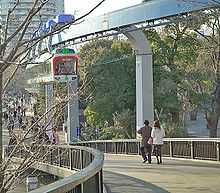Suspension railway
A suspension railway is a form of elevated monorail where the vehicle is suspended from a fixed track (as opposed to a cable used in aerial tramways), which is built above street level, over a river or canal, or an existing railway track.
History
Palmer System and Cheshunt Railway
The British engineer Henry Robinson Palmer (1795–1844) filed a patent application for a horse-drawn suspended single-rail system in 1821, and constructed a demonstration at Woolwich Arsenal soon afterwards.[1]
German industrial pioneer, thinker and politician Friedrich Harkort built a demonstration track of Palmers' system in 1826, in Elberfeld, Germany, at the time commercial centre of the early industrial area Wupper Valley. The steelmill owner had the vision of a coal-carrier railway between Wupper Valley and the nearby coal-mining region of Ruhr, which would connect his own factories in Elberfeld and Deilbachtal. Due to protests from mill owners that were not integrated along the line and from the transporting branch, this idea could not be executed.[2]
The first suspended railway was opened at Cheshunt on June 25, 1825 using Palmer's patent. It was actually built to carry bricks, but as an opening stunt it carried passengers, in doing so writing monorail history.[1][3]
A work, Description of the suspension railway invented by Maxwell Dick: with engravings By Maxwell Dick, published in Irvine, Scotland in 1830, refers to an Aerial tramway/cable car system.[4]
Enos Electric Railway
The Enos Electric Railway, an electric powered monorail with wagons suspended from an elevated frame of open steelwork, was demonstrated in the grounds of the Daft Electric Company in Greenville, New Jersey in 1886. It was built out of lightweight steel construction and had a great performance, but to circumstances unclear till now, was never expanded.[5][6]
The design of the rail-frame appears to have influenced Eugen Langen, or his mechanicians in designing the first elevated tramwaz, as his Wuppertal Schwebebahn framing bear a remarkable likeness to the Enos construction.
Electrical Elevated Railway System Eugen Langen or Floating Tram

The installation and stations were built by three companies, among them the company of Friedrich Harkort. In 1901 the first track of the Wuppertal Schwebebahn opened, in 1903 it was extended to the final length of 13.3 kilometres (8.3 mi). This system is still in operation as a normal means of public transport, moving over 20 million passengers each year.
Langen also designed the Schwebebahn Dresden, a short funicular railway using the same suspended monorail technology, which opened in 1901 and is still in operation.
1930s
A unique demonstration electrically powered suspension line was built by the Scottish engineer George Bennie near Glasgow. Two propellers delivered 240 horsepower (180 kW) in a short burst for acceleration to the cruise speed of 160 km/h.[3] It was not a true monorail as it used an overhead running rail and a guide rail below.
1950s
In 1947, Lucien Chadenson became interested in the Bennie Railplane experimental line, and the Paris Metro Route 11, which uses rubber tyres. A test track operated in Chateauneuf, south of Paris from 1958, but attracted no further interest in France. However, the Japanese have built two successful SAFEGE lines, the Siemens Company of Germany has developed a smaller scale system similar to the SAFEGE Monorail. and Aerorail of Texas and Sky Train of Florida are promoting steel-wheel versions of SAFEGE as well. Japan would later adopt the Alweg and Safege monorail systems and build more transit monorails than any other country in the world.[3]

The Ueno Zoo Monorail is a 0.3 km (0.19 mi) long suspended monorail operated by the Tokyo Metropolitan Bureau of Transportation (Toei). It is similar to the Schwebebahn Wuppertal, but has rubber tires rather than steel wheels.[9] The line began operating on December 17, 1958.
1970s and 1980s
Based on the SAFEGE design, the Shonan Monorail opened in 1970 in Kamakura, Japan - part of the Greater Tokyo area. It continues in operation today. The Chiba Urban Monorail, also in Japan, is the world's largest suspension railway; it is owned and operated by Chiba Urban Monorail Co. Ltd, established in 1979, and the monorail began service in 1988.
Two further H-Bahn suspension railways were built in Germany in 1975, at Dortmund and Düsseldorf airport. The Memphis Suspension Railway was opened in the United States in 1982.
Skybus Metro
The Skybus Metro is a modern suspended railway invented by Indian technologist Mr B Rajaram. The system consists of an elevated track with the cars suspended below the track, like the Wuppertal Schwebebahn or H-Bahn systems in Germany. A 1.6-kilometre (0.99 mi) test track in Margao, Goa started trials in 2004, but on September 25, one employee was killed and three injured in an accident.[10] After this, all development of the project stopped. However, Mr B Rajaram has defended the mode of transport, as he believes the accident was avoidable.[11]
References
- ↑ 1.0 1.1 http://www.albury-field.demon.co.uk/bxind.htm
- ↑ ref|http://www.lerntippsammlung.de/Friedrich-Harkort.html
- ↑ 3.0 3.1 3.2 http://www.monorails.org/tmspages/History.html
- ↑ http://www.irvinetimes.com/news/kilwinning/articles/2013/06/14/460750-ayrshire-uncovered
- ↑ http://www.hksconsultants.com/skytrain/history.html
- ↑ "Images of America - Winthrop", page 38, Winthrop Historical Commission, Charleston SC, 2002, ISBN 978-0-7385-0952-5
- ↑ http://www.deutz.de/live_deutz_com/file/chronik_de/app.html
- ↑ "Denkschrift betreffend die Anlage einer elektrischen Hochbahn (Schwebebahn), System Eugen Langen Köln für Berlin". „Gasmotoren-Fabrik Deutz AG“, Köln 1894. Retrieved 2001-11-20. to be found in the collection of the AG Sammlung Deutsche Drucke.
- ↑ "Ueno Zoo". Retrieved 2007-03-30.
- ↑ "National : Sky Bus Metro resumes after 3 months". Chennai, India: The Hindu. 2004-12-23. Retrieved 2010-08-11.
- ↑ https://docs.google.com/document/pub?id=1yYQcyramb5wecESziWdwWZtxdXkZpUQ897COcdE8H1I

